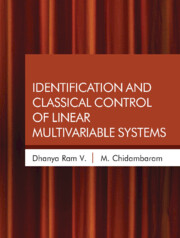Book contents
- Frontmatter
- Contents
- Preface
- Acknowledgements
- List of Abbreviations
- Notations
- 1 Models, Control Theory, and Examples
- 2 Identification and Control of SISO Systems
- 3 Introduction to Linear Multivariable Systems
- 4 CRC Method for Identifying TITO Systems
- 5 CRC Method for Identifying SISO Systems by CSOPTD Models
- 6 CRC Method for Identifying TITO Systems by CSOPTD Models
- 7 Identification of StableMIMO System by Optimization Method
- 8 Identification of Centralized ControlledMultivariable Systems
- 9 Identification of Multivariable SOPTD Models by Optimization Method
- 10 Identification of Unstable TITO Systems by Optimization Technique
- 11 Centralized PI Controllers Based on Steady State Gain Matrix
- 12 SSGM Identification and Control of Unstable Multivariable Systems
- 13 Control of Stable Non-square MIMO Systems
- 14 Control of Unstable Non-square Systems
- 15 Trends in Control ofMultivariable Systems
- Appendix A Identification of Unstable Second Order Transfer Function Model with a Zero by Optimization Method
- Appendix B For Chapter 3
- Appendix C For Chapter 7
- Bibliography
- Index
9 - Identification of Multivariable SOPTD Models by Optimization Method
Published online by Cambridge University Press: 31 July 2022
- Frontmatter
- Contents
- Preface
- Acknowledgements
- List of Abbreviations
- Notations
- 1 Models, Control Theory, and Examples
- 2 Identification and Control of SISO Systems
- 3 Introduction to Linear Multivariable Systems
- 4 CRC Method for Identifying TITO Systems
- 5 CRC Method for Identifying SISO Systems by CSOPTD Models
- 6 CRC Method for Identifying TITO Systems by CSOPTD Models
- 7 Identification of StableMIMO System by Optimization Method
- 8 Identification of Centralized ControlledMultivariable Systems
- 9 Identification of Multivariable SOPTD Models by Optimization Method
- 10 Identification of Unstable TITO Systems by Optimization Technique
- 11 Centralized PI Controllers Based on Steady State Gain Matrix
- 12 SSGM Identification and Control of Unstable Multivariable Systems
- 13 Control of Stable Non-square MIMO Systems
- 14 Control of Unstable Non-square Systems
- 15 Trends in Control ofMultivariable Systems
- Appendix A Identification of Unstable Second Order Transfer Function Model with a Zero by Optimization Method
- Appendix B For Chapter 3
- Appendix C For Chapter 7
- Bibliography
- Index
Summary
In this chapter, the identification method for a First Order Plus Time Delay (FOPTD) model, discussed in Chapter 7, is extended to identify a Second Order Plus Time Delay (SOPTD) model of multivariable systems. This chapter discusses the need for step-up and step-down excitation in the set points to obtain the parameter convergence with significantly reduced computational time.
Introduction
It should be observed that the time domain identification method is easier to formulate and it is conceptually simple. Viswanathan et al. (2001) presented a method for the closed loop identification of FOPTD and SOPTD models by using genetic algorithm (GA) for TITO systems. The computational time for the identification of a SOPTD TITO system using the GA (Viswanathan et. al, 2001) ranges from 1 hour 55 minutes to 5 hours 28 minutes (for different controller settings and test timings). Further, the converged values from GA are not reliable. The converged values are refined by using a local optimizer (Gupta, 1995) (Broyden–Fletcher–Goldfarb–Shannon method). For the SOPTD model identification, Viswanathan et al. (2001) reported the success rate for 10 trials ranging from 25% to 100% to get the global minimum. There is no guarantee to get the exact transfer function model (global minimum) in a single trial. If we obtain the least IAE values also, some deviations are found among the time constant and the damping coefficient (similar to what we get in any model reduction technique). They provide success rate, in which howmany times, they obtained the global minima (exact model parameters) or local accepted minima are not clearly specified. It is to be inferred that the attainment of global minimum (in SOPTD model identification test) is difficult from the step response. The computational time given above is for one trial. The computational time is higher (about 20 to 50 hours) considering together all the 10 trials. Viswanathan et al. (2001) have presented the upper and lower bounds for the parameters in the GA arbitrarily for each of the simulation examples.
For the limit values of process gains, Viswanathan et al. (2001) used a method reported by Papastathopoulo and Luyben (1990). It requires the process input data also for obtaining the guess values of steady state gains.
- Type
- Chapter
- Information
- Publisher: Cambridge University PressPrint publication year: 2023

